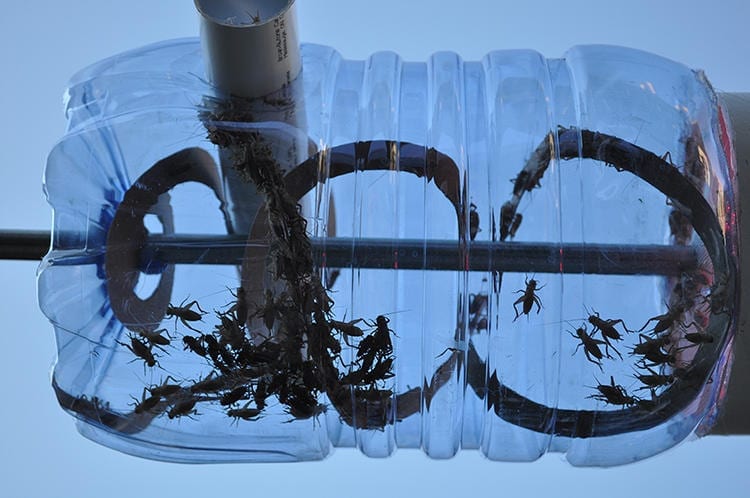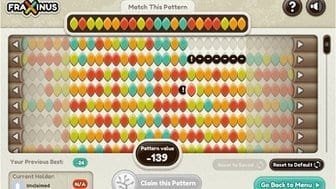
Crickets are a delectable, affordable, and environmentally friendly protein source already eaten in some parts of the world. Now the trick is producing them for the masses.
His wife once threatened to kick him out, his landlord might evict him, and he could go broke. But Jakub Dzamba, a Ph.D. student in architecture at McGill University and founder of a company called Third Millennium Farming, is nevertheless on a mission to popularize a farming system for a food that sometimes makes even his advisors flinch: crickets.
Insects are among the world’s most environmentally friendly sources of protein, and though not common in Western nations, are already an everyday cuisine in many parts of the world. In the U.S., there’s growing curiosity about crickets as a sustainable food source (see our recent coverage of these cricket flour-based protein bars and these pre-packaged insect meals). Yet if insects are ever to hit the big time, there needs to be a way to mass produce the “micro-livestock.”
Cricket farms exist today, often to produce reptile or fish food. But they can be messy industrial operations, says Dzamba. Instead, he wants to make it easy (and not at all creepy) to farm crickets locally in an office building or neighborhood by creating “cricket reactors“–enclosed cricket breeding contraptions fed by recycled organic wastes like lawn clippings and kitchen scraps.
His apartment contains one of a few working prototypes. (His wife almost kicked him out when a few escaped, motivating him further to perfect a system of levers, valves, and sliding doors that make it “escape proof.”)
One larger version, which costs about $50 to $100, would be intended for a facility or enthusiast to use. Another, which he is developing now, would be a “personal” countertop cricket farm that could cost as little as $3 and produce about 10 pounds of crickets every eight weeks, or enough protein for one adult to subsist on.
In the reactor, the crickets are killed after laying their eggs, so the farm is self-sustaining. The temperature is lowered until the crickets fall asleep; then they are frozen. “You still have to kill an animal, but it’s more humane,” he says.
The Latest Bing News on:
Sustainable Insect Factory Farm
- The Current State of the Science of Insect Sentienceon May 3, 2024 at 8:25 am
Factory farms cause a lot of unnecessary harm ... people are hunting for sustainable alternatives to the status quo. Some think that insects are going to be a big part of a greener food system and, as ...
- Maltento’s sustainable Black Soldier Fly factory opens a world-class laboratoryon April 24, 2024 at 5:00 pm
but also contributing to the sustainable development of the agriculture and aquaculture sectors. This innovative approach demonstrates Maltento's commitment to leveraging insect biotechnology for ...
- Unlocking the potential of insects as sustainable protein sourceson April 24, 2024 at 4:25 am
Could insects be a viable alternative source of protein in our diets? Researchers from the University of Surrey need your help to get to the bottom of this much-debated question.
- Modular Insect Farms Successfully Turn Organic Waste Into Sustainable Proteinon April 8, 2024 at 9:53 pm
London, UK – Flybox, a pioneer in sustainable agriculture, proudly announces the successful deployment of its innovative modular insect farms, revolutionising the way organic waste is ...
- This San Mateo ‘Snackeria’ Wants to Popularize Edible Insectson January 18, 2024 at 4:00 pm
No hormones or antibiotics. We allow the insects to follow their natural life cycles. We respect that. We tap into that to save resources. We call our farm a “holistic farm.” We are an organic farm, ...
- Factory Farming, GMOs, and Corporate Greed: Debunking 10 Myths of Agricultureon September 18, 2023 at 4:28 pm
Modern agriculture practices ... uncommon for farmers to grow a both organic and conventional crops across the fields on which they operate). Myth 4: Factory farms are inhumane and cruel to ...
- French Insect Company Ÿnsect launches New Pet-Food Brandon May 15, 2023 at 6:31 am
I write about sustainable food & agriculture production systems ... many companies are beginning to include insects in their food formulations. According to Paris-based company, bugs are the ...
- Biotech Startup Loopworm Raises Funding To Build Sustainable Insect-Based Proteinon August 23, 2022 at 4:59 pm
Loopworm plans to use the funds for talent acquisition, building research and development capabilities and launching its first factory for ... 300,000 MT of sustainable insect-based protein ...
- Insect farming is booming amid demand for more sustainable foodon January 20, 2022 at 11:30 pm
It is one of an increasing number of Japanese businesses getting into edible insect farming, as bugs draw more and more attention as a sustainable food source. The trend, originally aimed at ...
- 17 Best Eco-Friendly Gifts for 2024on May 3, 2021 at 5:00 pm
These sustainable products can help the planet ... amazing products made from recycled ocean plastic. Cuts. Scrapes. Insect bites. Sunburns. Itching. Scars. Dry skin. Everyone gets them!
The Latest Google Headlines on:
Sustainable Insect Factory Farm
[google_news title=”” keyword=”Sustainable Insect Factory Farm” num_posts=”10″ blurb_length=”0″ show_thumb=”left”]
The Latest Bing News on:
Insect Factory Farm
- New Florida resident Jeff Bezos pumped $60 million into making lab-grown meat taste better. Ron DeSantis just banned it from the stateon May 3, 2024 at 2:09 pm
An announcement about the legislation went viral for reasons completely unrelated to meat of any kind—"It’s the worst picture of me,” reality star says.
- Insect Repellent Buying Guideon May 2, 2024 at 5:00 pm
Our insect repellent ratings identify which products work best against these bugs. (We currently don’t systematically test our products against ticks, but past test results indicate that ...
- Sealing System launches: XIO – Intelligent Farmingon April 25, 2024 at 5:00 pm
ENORM Biofactory is Northern Europe’s first large-scale commercial insect factory. With a projected production capacity of over 10,000 tonnes of insect meal annually, this facility is set to ...
- 7 Most Common Insects To Look Out For In Your New Homeon April 23, 2024 at 3:33 pm
Even if you don’t see common household bugs, you should still be aware of subtle signs that your new home has an insect problem. Depending on the types of insects in your home, the risk to you ...
- Your yard can help avert the insect apocalypse. Here’s how.on April 23, 2024 at 3:31 am
(The average home contains 100 insect species, virtually all of them harmless.) Insects, a vast biological family composed of more than a million species, rank among the most successful organisms ...
- In Vietnam, farmers reduce methane emissions by changing how they grow riceon April 22, 2024 at 7:22 pm
Vietnam aims to transform its rice sector, making it more resilient to climate change while also reducing its emissions of methane, a greenhouse gas far more potent than carbon dioxide ...
- The Best Bug Repellentson April 13, 2024 at 8:25 am
We’ve updated this guide with some new dismissals and have added Off! Clean Feel Aerosol Insect Repellent to our list of effective repellents. April 2024 Everyone should avoid bug bites ...
- Buzzy Business: This Singapore-Based Startup Raised $28 Million To Grind Flies Into Farm Foodon November 27, 2023 at 6:08 pm
Chiefly operating out of a two-hectare factory across the border in Malaysia ... in the Thai market or overseas market.” In the buzzy insect-as-feed sector, Rattanasombat says Nutrition ...
- Lessons From The Bug Factory: How Tiny Farms Is Redefining The Cricket Businesson January 28, 2017 at 7:29 pm
Andrew and his wife, Jena Brentano, both 29, used to run their own Web design firm, before they teamed up with Daniel Imrie-Situnayake, a software engineer, 30, to build their urban insect farm.
The Latest Google Headlines on:
Insect Factory Farm
[google_news title=”” keyword=”Insect Factory Farm” num_posts=”10″ blurb_length=”0″ show_thumb=”left”]









